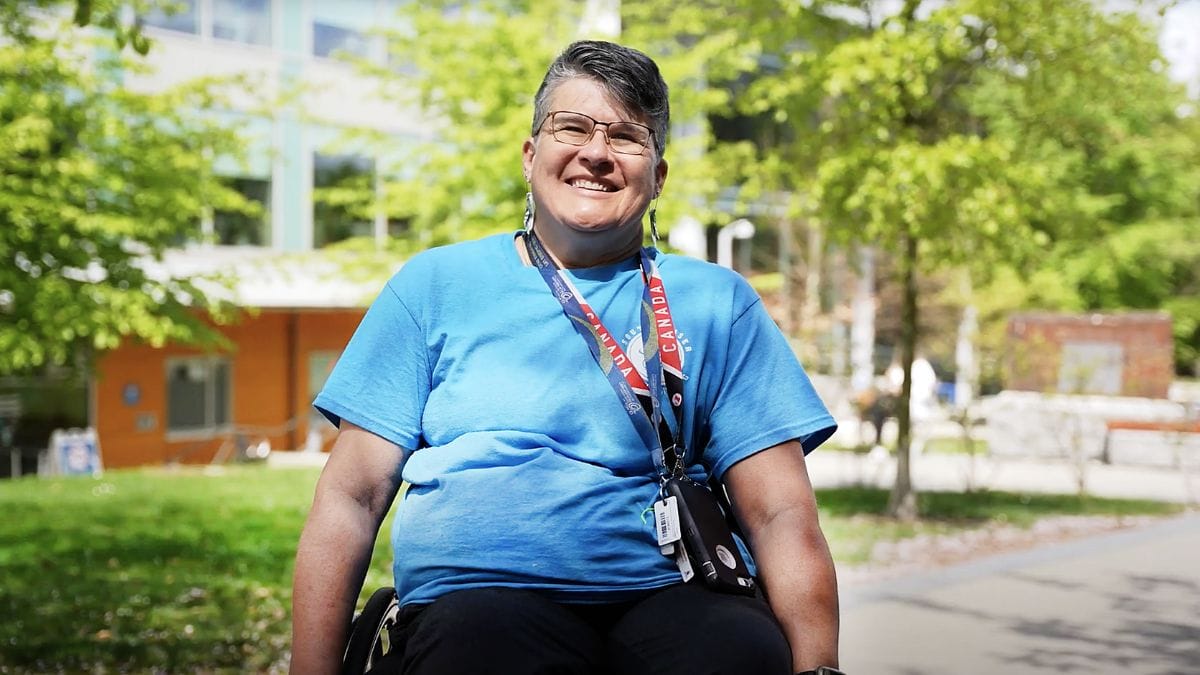Question: what’s something used by half the world’s population that can improve respiratory function, posture and self-esteem, but is one of the most commonly misinformed purchases? Answer: a bra.
And for people with SCI, the benefits of wearing the right bra are even more significant. “A person is a person, and a body is a body, and it’s important not to confuse the two,” says Jolaine Crawford, an SCI BC Peer from Creston, BC who has spent a great deal of her post-injury life fighting for this distinction to be recognized. Crawford explains that, after a medical error during surgery resulted in a T6 SCI, she’s had to overcome many roadblocks in order to receive adequate care, feel confident in her body, and be recognized first and foremost as a whole person. A recent bra shopping trip presented yet another of these challenges. “It made me feel ugly, damaged, and self-conscious,” she says. “I wasn’t listened to, and my body’s needs weren’t appraised in the context of a whole person.”
Because Crawford has diaphragmatic spasms and respiratory complications from her injury, her bra needs are different than those of many others. Her ideal bra would provide support without putting pressure on her lower sternum or rib cage, and would be comfortable to wear while sitting for long periods in her chair.
In other words, for Crawford and others with SCI, wearing the right bra is more than a matter of aesthetic or practicality—it’s a matter of health. Enter Esteem Lingerie, an independent lingerie boutique in West Kelowna that Crawford recently visited. The boutique is owned and operated by the mother and daughter team of Florenda Pickett and Angela O’Brien. For 13 years, the duo has been committed to providing women with high quality products and bra fitting education that results in improvements in self-esteem and health.
“We wanted Esteem Lingerie to be a place of acceptance of women’s bodies, where women of all figure types and sizes could find bras and underwear that works for their bodies,” says O’Brien. When Crawford went to Esteem Lingerie, that’s exactly what she found. “I felt resurrected,” she says. “That’s an odd word to describe a shopping experience, but I think it’s fitting. I left feeling whole and far more knowledgeable about how to manage my heath condition.”
Knowledge is key to Esteem’s mission, says O’Brien. “The purpose of a bra is to support the weight and volume of the breast in a position that supports postural alignment and allows for deep breathing,” she explains, adding that, although this goal is often overlooked in favour of fancy colours and fabric, it’s essential for overall health and wellness. “An ill-fitting bra can increase the stress on the back, neck and shoulders, which contributes to poor postural alignment and can impact proper breathing,” she continues.
For Crawford, getting the proper fit was immensely important.
“I learned the science behind the bra—how this would reduce stresses on my cardio-pulmonary system and vertebral column,” she says. Crawford encourages others to explore their bra options and to keep looking for solutions that work for them. “Pick up the phone, look on the internet, find people like Angela,” says Crawford. “The bra fitting wasn’t dependent on anyone helping improve my life other than me following through…I survive by thinking outside the box.”
The BRAss Tacks
Angela O’Brien, co-owner of Esteem Lingerie, shares her top eight facts and tips about bras and breast health so you can avoid shopping trip fiascoes and find your perfect fit.

- Those with smaller breasts and limited hand function might consider looking for bras that can be pulled over the head, rather than done up behind the back.
- A front opening hook and eye system on bras may also be a good fit for those with limited range of motion or lower hand function—you have a better view and more control!
- Bras have 22 fit points, which may be different for everyone. You may be a C cup in one brand and a DD cup in another. Every manufacturer has a different fit, so be prepared to explore.
- In order to provide effective support, a bra should fit like a comfortable second skin, offer a nice, snug hug, and have the flexibility to move with the body throughout the day. It’s important to be honest and upfront about your body’s needs so you can find the best possible fit!
- Without the support of a properly fitted bra, breast tissue—which has no muscle—lays against the torso causing three main issues:
1. Skin breakdown under the breast due to a build-up of moisture, bacteria and heat in a dark environment.
2. The weight of the breast pulling on the upper back, neck and shoulder can lead to poor posture and increased tension and pain in these areas.
3. The weight of the breast laying on the lower rib cage makes proper expansion of the lower lungs while breathing even more challenging, even with good posture.
- Non-wire bras that have more support across the back and under the arms can help lift breasts higher on the torso without the pressure of underwires.
- In North America, the average cup size on a given band is actually an E (sometimes known as a DD) to F cup, yet the average size range of bras carried by big box stores and chains only fit about 10% of people!
- We suggest to clients with special physical considerations to purchase one garment and test it out before purchasing more. Quality bras may cost a little more up front but they tend to last longer and are well worth the investment.
Learn more about Esteem Lingerie online at esteemlingeriegroup.ca, by phone at 250-768-0171, or in-person at #23-2484 Main Street, Westridge Centre Mall in West Kelowna. Esteem Lingerie also offers seminars for groups and healthcare providers on the subject of bra health— they’re always happy to connect!
This article first appeared in our Fall 2019 issue of The Spin and has been edited for our blog. Read the full version alongside other stories, including:

- Accessible Gaming
- Shoulder Pain Research
- Cabin Fever: BC Parks Debuts Accessible Cabins
- and more!



